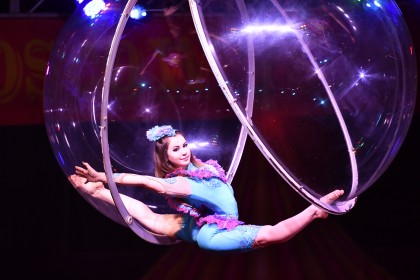Why you can trust TechRadar
As it has 'just' 20 million pixels on its sensor the D5 can't compete with the 36MP D810 for detail resolution, but it compares very well with the 24MP D750, matching or beating it throughout the sensitivity range in our resolution tests. It also beats the 16MP D4S up to ISO204,800, after which the older camera pulls ahead – this is deep into the D4S's expansion range, and one stop into the D5's.
Significantly, in real-world shooting the D5 produces much better-looking images at ISO409,600 – the D4S's maximum extension value. The images are still very noisy, and I wouldn't recommend using this value routinely, but there's less banding visible; it could be a useful option in extreme circumstances.
Moving up to the D5's maximum sensitivity setting (ISO3,280,000) results in a significant drop in image quality. In the low lighting conditions that demand such a high setting there's little detail in either the raw or JPEG files. With no noise reduction applied, raw files have lots of chroma noise (coloured speckling) and a check pattern of banding visible at normal viewing sizes.

Click here for the full-resolution image

Click here for the full-resolution image

Click here for the full-resolution image
Simultaneously captured JPEGs are much softer-looking, as if a watercolour filter has been applied, and there's magenta banding. There could be a use for this setting for surveillance work, when it may be necessary to record the location of large objects, but it's unlikely to be used often. Many details are rendered unrecognisable, although some outlines are visible.
The lower high expansion settings produce better results, and could be of use for reporting when image quality isn't the prime concern, but as a rule I'd recommend keeping below ISO102,400.
The D4S has a strong reputation for autofocus system performance, and the D5 takes things further, not least with a 102-point increase in the number of AF points. When the active AF point is over the subject the D5 does an excellent job of keeping it sharp in single-point AF mode. However, the 25- and 72-point dynamic-area AF options increase the chances of an active AF point being over the subject, and increase the hit rate with subjects that move around the frame as well as changing distance to the camera.

Click here for the full-resolution image

Click here for the full-resolution image
Click here for the full-resolution image
The 153-point and Auto-area AF modes can be helpful, but in busy surroundings there's an increased chance of the camera latching on to the wrong target – especially in low light and/or low contrast situations.
When photographing at a low-light go-karting track I was acutely aware of when I had the active AF point/area over the subject – when this was the case the camera did an excellent job of keeping the subject sharp. The 3D tracking option can be useful, but it relies on a strong colour contrast between the subject and the background, if this isn't the case it tends to get distracted, and jump to other areas of the frame.
In other respects the D5 performed well; the Matrix metering system is fairly easily influenced by very dark or bright sections in the scene, but it's usually predictable. In the high-contrast conditions of the Moscow State Circus, for example the dark surroundings tricked the Matrix system into overexposing the brightly illuminated subject; centre-weighted metering was a better choice.
Click here for the full-resolution image

Click here for the full-resolution image
Colour-wise, the D5 tends towards quite subtle tones in the natural environment when using the Standard Picture Control mode, which is likely to appeal to photographers who are used to processing files. In other instances, with bolder colours, images look more vibrant and punchy – our lab tests indicate that the camera tends towards higher saturation, which is often more attractive.
The video produced by the D5 is of high quality, with good colour and plenty of detail.
